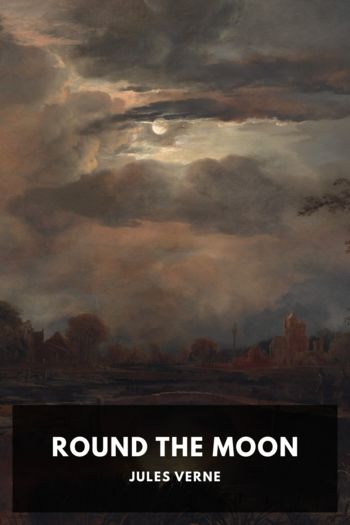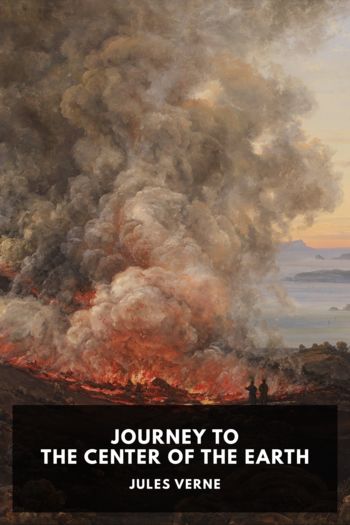Round the Moon by Jules Verne (read aloud txt) 📕

- Author: Jules Verne
Book online «Round the Moon by Jules Verne (read aloud txt) 📕». Author Jules Verne
“It is snow,” cried he.
“Snow?” echoed Nicholl.
“Yes, Nicholl, snow, the surface of which is profoundly frozen. Look how it reflects the luminous rays. Cooled lava would not give so intense a reflection. Therefore there is water and air upon the moon, as little as you like, but the fact can no longer be contested.”
No, it could not be, and if ever Barbicane saw the earth again his notes would testify to this fact, important in selenographic observations.
These Mounts Doerfel and Leibnitz arose in the midst of plains of moderate extent, bounded by an indefinite succession of amphitheatres and circular ramparts. These two chains are the only ones which are met with in the region of amphitheatres. Relatively they are not very broken, and only throw out here and there some sharp peaks, the highest of which measures 7,603 metres.
The projectile hung high above all this, and the relief disappeared in the intense brilliancy of the disc.
Then reappeared to the eyes of the travellers that original aspect of the lunar landscapes, raw in tone, without gradation of colours, only white and black, for diffused light was wanting. Still the sight of this desolate world was very curious on account of its very strangeness. They were moving above this chaotic region as if carried along by the breath of a tempest, seeing the summits fly under their feet, looking down the cavities, climbing the ramparts, sounding the mysterious holes. But there was no trace of vegetation, no appearance of cities, nothing but stratifications, lava streams, polished like immense mirrors, which reflect the solar rays with unbearable brilliancy. There was no appearance of a living world, everything of a dead one, where the avalanches rolling from the summit of the mountains rushed noiselessly. They had plenty of movement, but noise was wanting still.
Barbicane established the fact, by reiterated observation, that the reliefs on the borders of the disc, although they had been acted upon by different forces to those of the central region, presented a uniform conformation. There was the same circular aggregation, the same accidents of ground. Still it might be supposed that their arrangements were not completely analogous. In the centre the still malleable crust of the moon suffered the double attraction of the moon and the earth acting in inverse ways according to a radius prolonged from one to the other. On the borders of the disc, on the contrary, the lunar attraction has been, thus to say, perpendicular with the terrestrial attraction. It seems, therefore, that the reliefs on the soil produced under these conditions ought to have taken a different form. Yet they had not, therefore the moon had found in herself alone the principle of her formation and constitution. She owed nothing to foreign influences, which justified the remarkable proposition of Arago’s, “No action exterior to the moon has contributed to the production of her relief.”
However that may be in its actual condition, this world was the image of death without it being possible to say that life had ever animated it.
Michel Ardan, however, thought he recognised a heap of ruins, to which he drew Barbicane’s attention. It was situated in about the 80th parallel and 30° longitude. This heap of stones, pretty regularly made, was in the shape of a vast fortress, overlooking one of those long furrows which served as riverbeds in ante-historical times. Not far off rose to a height of 5,646 metres the circular mountain called Short, equal to the Asiatic Caucasus. Michel Ardan, with his habitual ardour, maintained “the evidences” of his fortress. Below he perceived the dismantled ramparts of a town; here the arch of a portico, still intact; there two or three columns lying on their side; farther on a succession of arch pieces, which must have supported the conduct of an aqueduct; in another part the sunken pillars of a gigantic bridge run into the thickest part of the furrow. He distinguished all that, but with so much imagination in his eyes, through a telescope so fanciful, that his observation cannot be relied upon. And yet who would affirm, who would dare to say, that the amiable fellow had not really seen what his two companions would not see?
The moments were too precious to be sacrificed to an idle discussion. The Selenite city, whether real or pretended, had disappeared in the distance. The projectile began to get farther away from the lunar disc, and the details of the ground began to be lost in a confused jumble. The reliefs, amphitheatres, craters, and plains alone remained, and still showed their boundary-lines distinctly.
At that moment there stretched to the left one of the finest amphitheatres in lunar orography. It was Newton, which Barbicane easily recognised by referring to the Mappa Selenographica.
Newton is situated in exactly 77° south lat. and 16° east long. It forms a circular crater, the ramparts of which, 7,264 metres high, seemed to be inaccessible.
Barbicane made his companions notice that the height of that mountain above the surrounding plain was far from being equal to the depth of its crater. This enormous hole was beyond all measurement, and made a gloomy abyss, the bottom of which the sun’s rays could never reach. There, according to Humboldt, utter darkness reigns, which the light of the sun and the earth could not break. The mythologists would have made it with justice hell’s mouth.
“Newton,” said Barbicane, “is the most perfect type of the circular mountains, of which the earth possesses no specimen. They prove that the formation of the moon by cooling was due to violent causes, for whilst under the influence of interior fire the reliefs were thrown up to considerable heights, the bottom dropped in, and became lower than the lunar level.”
“I do not say no,” answered Michel Ardan.
A few minutes after having passed Newton the projectile stood directly





Comments (0)